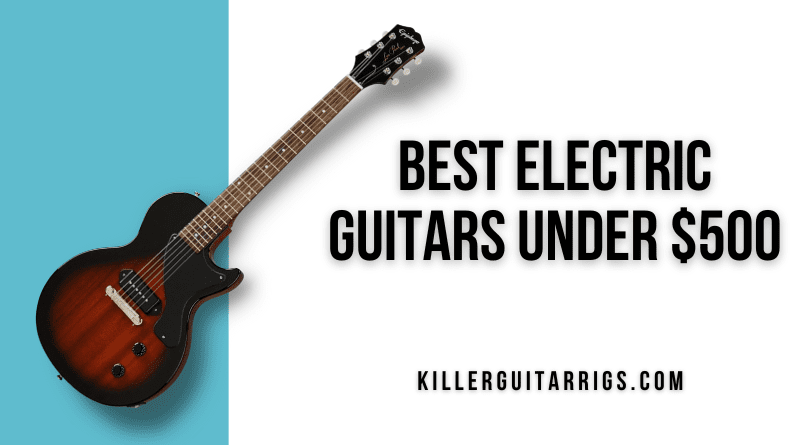Not all that long ago, $500 wouldn’t stretch far if you were trying to find a reliable guitar, but that’s not the case anymore, in fact the best electric guitars under $500 offer the kind of performance, playability and reliability that even some high end models weren’t delivering in years gone by – case in point is the Epiphone Les Paul Junior. As you’d expect from a Les Paul, it’s built with a mahogany body and neck, and offers an authentic playing experience thanks to its Vintage ‘50s neck. It comes with vintage style deluxe tuners and a wraparound bridge, both of which contribute to its excellent tuning stability and intonation. The single P-90 pickup is ideal for a range of styles, handling cleans with ease, and serving up gnarly growl when pushed into overdrive. The Epiphone Les Paul Junior is a fantastic choice for players of all abilities, delivering back to basics performance, and an overall excellent playing experience, which is why we’ve named it as our best electric guitars under $500 Top Pick.
In the event you’re able (and willing) to stretch to the very top end of the budget, we think the Yamaha Revstar Element RSE20 is a great choice. Its unique style really sets it apart from anything else on the market – it’s clearly inspired by other models, but is still distinctly its own design. It offers a dual humbucker pickup layout, and Dry Switch technology, which, like a coil split, serves up a brighter, single coil style tone, but without the 60 cycle hum. It features set neck construction, along with a mahogany body and rosewood fretboard, all of which contribute to its warm, resonant tone. The hardware is all of outstanding quality, and the overall fit and finish is very much up to Yamaha’s exacting QA standards. We think with Yamaha Revstar Element RSE20 you’re getting way more guitar than you’re actually paying for, making it a deserving winner of our best electric guitars under $500 Editor’s Choice.
One of our favorite options, and also one of the most affordable, is the Squier Affinity Series Stratocaster HSS in Sienna Sunburst. In terms of aesthetics, this model is far above and beyond anything else in its price range with its gorgeous flamed maple veneer, and fantastic sunburst finish. As for its pickup layout, it has a humbucker in the bridge, and single coils in the middle and neck positions, making it a great choice for all genres. Despite its low price, it’s fitted with quality tuners, and a modern (and reliable) 2 point Synchronized Tremolo system. It’s both comfortable and forgiving thanks to its C shape neck profile and body ergonomics, meaning that the Squier Affinity Series Stratocaster HSS is a solid option for a huge range of ability levels, making it the obvious choice for our best electric guitars under $500 Best Budget award.
Read more about our review process.

Yamaha Revstar Element RSE20
Features: Mahogany body, Humbucking pickups, Dry switch
Benefits: Super versatile tones, Exceptional Build quality, Fantastic styling

Epiphone Les Paul Junior
Features: P90 Pickup, Set neck construction, CTS electronics
Benefits: Genuine vintage tones, Great playability, Classic P90 growl
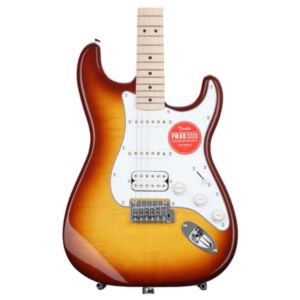
Squier Affinity Series Stratocaster
Features: HSS Pickups, Flamed maple top, Lightweight poplar body
Benefits: Comfortable to play, Super forgiving neck, Great tonal range
Contents
Individual Reviews
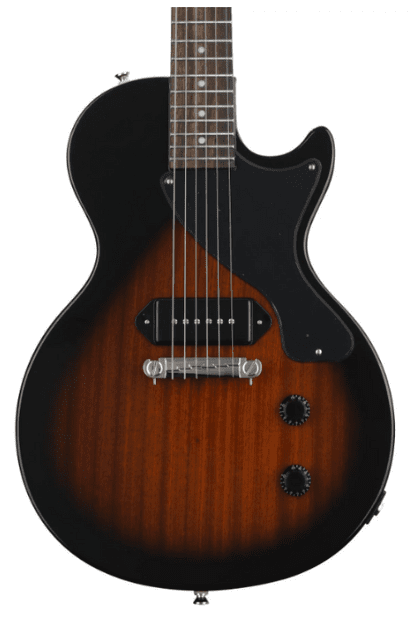
Epiphone Les Paul Junior
Surprising versatility from one of the purest guitars on the market.
Players looking for a great blend of price and performance will love this Epiphone. It offers outstanding performance, and specs that are almost indistinguishable from its big brother in the Gibson lineup. You get quality woods, high end components, and phenomenal tone from this punk icon.
The Epiphone Les Paul Junior needs little introduction. It’s modeled after the Gibson LP Jr., which started life as a student grade version of their more expensive Les Paul models, before it gained its own cult following.
It had a slab style mahogany body, but because there was no maple cap like most Les Pauls, the weight was kept to a minimum and we found it to be very comfortable to hold and play. It had a Tobacco Burst finish, which incidentally is the only available color – but it’s such an iconic look we weren’t mad about the lack of choice.
Not only does it have a truly vintage aesthetic, but it also has a true vintage feel – the neck had Epiphone’s ‘50s C Profile, which is one of the beefiest you’ll find on any guitar in this price range. We loved the feel, and if you like thick necks, we think you will, too. The neck was carved from mahogany, and set into the body, just as you’d find on a Gibson.
On the front side, there was an Indian Laurel fretboard, which felt great under the fingers, and looked great with the body finish. The fretwork was also well done, with nice smooth edges, and level crowns with a good polish.
We were particularly impressed with the range of tones we managed to wring out of the single P90 pickup. We got everything from shimmery cleans, to rich and warm blues tones, right through to the trademark growl that has made the LP Jr. such an icon on the punk and rock scene.
As briefly mentioned, the beauty of the Les Paul Junior lies in its simplicity. It makes use of quality hardware, with vintage style Epiphone Deluxe tuners, and a simple compensated bridge, both of which contribute in a big way to the flawless tuning stability and excellent intonation.
Verdict: We highly recommend the Epiphone Les Paul Junior to players of all ages and abilities. It offers superb playability, it has a simple design that all but ensures superb reliability, and the range of tones is hugely dynamic considering it has only 1 P90 pickup. It really forces you to learn how to adjust the tone and volume dials to manipulate the sound, which can ultimately make you a better player.
- Classic style
- Extremely reliable
- P90 Snarl
- Single pickup limits tonal options
- Only one color choice
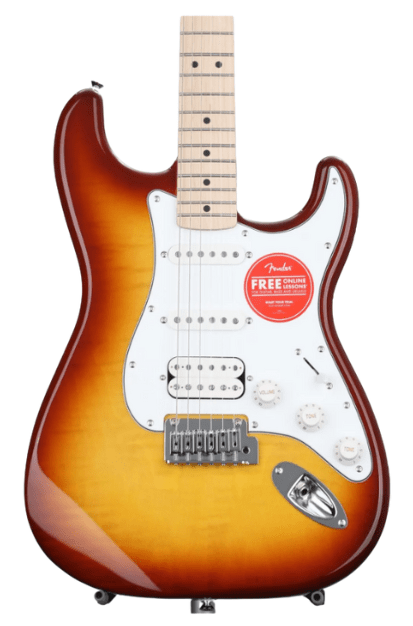
Squier Affinity Series HSS Stratocaster
A budget Strat with high end aesthetics and great tones.
With this Strat you’re getting a fantastic platform for learning guitar and progressing quickly. It offers both humbucker and single coil pickups, which allow for a great range of tones, from thick searing leads to classic Stratocaster quack and chime. It also happens to be one of the best looking guitars Squier has produced to date!
The Squier Affinity Series Stratocaster has had some serious upgrades over previous versions of this best selling model, and we were genuinely impressed with the improvements on not just the looks, but the tones and playability, too.
The lightweight poplar body was topped off with a fantastic flamed maple veneer that looed superb beneath the Sienna Sunburst finish. One thing to note is that because this is an Affinity Series model, it doesn’t have a full thickness body.
It had a comfortable maple neck with a C shape profile. It had a great feel, and while it wasn’t quite as hefty as the Les Paul’s neck, it gave us plenty to hold on to. The fretboard was maple, too; we found that it had a nice feel under the fingers, and we also found that the fretwork was nicely finished, too. Older Squier guitars weren’t exactly known for quality fretwork, so it was great to see so much attention to detail with this guitar.
We really liked the pickups on the Affinity Strat. Being ceramic, they were quite hot, but they still let us dial in some great tones. It had a HSS configuration, which is something that can add a lot of versatility to a Strat. We found that the bridge position was nice and thick, and gave us some great lead tones without the noise, and in the neck, we got some great warmth. Intermediate positions quacked just like they should, leaving us with a great overall impression.
Fit and finish on this guitar was far better than we’ve seen on Affinity series Squiers of years gone by. Gone are the old bent pot metal saddles, and in their place modern style adjustable pieces like those found on US models. The sealed die cast tuners did their jobs well, too; they held strong for great stability and allowed for easy fine tuning.
Verdict: The Squier Affinity Series Stratocaster delivers on all fronts when it comes to Strat tones, and at an unbelievable price when you consider all you’re getting. It offers great playability, it looks better than anything else at its price point, and above all else offers reliable performance.
- Versatile tones
- Stunning finish
- Light weight
- Partial thickness body
- Ceramic pickups
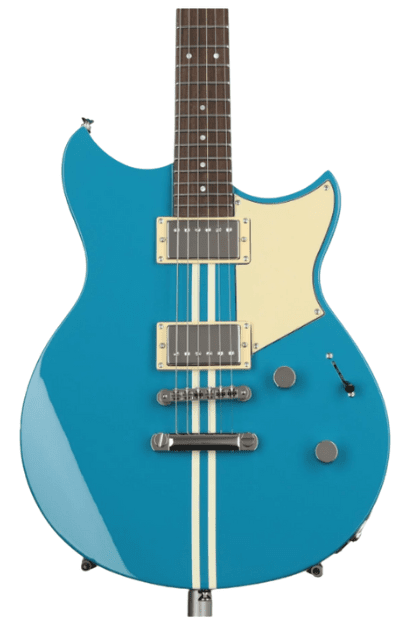
Yamaha Revstar Element RSE20
Superb performance and quality that rivals guitars at twice the price.
This model is one of Yamaha’s newest designs, and it’s unlike anything else out there. It’s beautifully balanced, and the chambered body provides incredible resonance. It boasts some trick electronics for tonal variety, and of course, it’s built with all the care and attention you’d expect from a Yamaha.
The Yamaha Revstar Element RSE20 is the entry level version of their latest Revstar series, and it’s a simply fantastic guitar that works for everyone from beginners to working musicians.
It had a lightweight chambered mahogany body, which we found to be extremely comfortable with excellent ergonomics. The entire design was well thought out, and promoted top playability whether playing seated or standing. We loved the Swift Blue finish; it looked amazing, and was perfectly set off by the off white racing stripes.
The set mahogany neck had an all new Revstar profile. It was a medium thickness C shape and it was brilliant to play. Fast, comfortable, and combined with the deep double cutaway, allowed for fantastic upper fretboard access.
Despite being an entry level model, it still came with a genuine rosewood fretboard – a pretty rare feature at this point, but having said that, one we’ve come to expect from Yamaha. It felt great, and looked even better. Fretwork was impeccable, with really well finished edges, and well polished crowns that served up a frictionless playing experience.
We were especially impressed with the tones we got from the Revstar. It had a pair of alnico V humbuckers which were very much PAF inspired. We got everything from bell like cleans, to thick, warm blues tones, right through to searing high gain metal sounds.
It was just an incredibly versatile and dynamic guitar, and we couldn’t put it down! The dry switch added even more range, and acted in a similar fashion to a coil split, sharpening the tone, without actually cutting a coil, delivering single coil tones, without the hum.
The overall build quality was far in excess of pretty much anything else with a $500 cap, and in reality, if this had a $1000 price tag, we wouldn’t be complaining. It had quality hardware, and rock solid tuning stability.
Verdict: The Yamaha Revstar Element RSE20 was a joy to play in every element. Playability was excellent, and the tones were brilliant. The styling was unique, and being a Yamaha, it was made with high end tone woods and quality hardware. If you’ve got $500 to spend on a new guitar, it really doesn’t get much better than this.
- Unique looks
- Great ergonomics
- Rosewood fretboard
- Often out of stock
- No individual pickup tone/volume controls
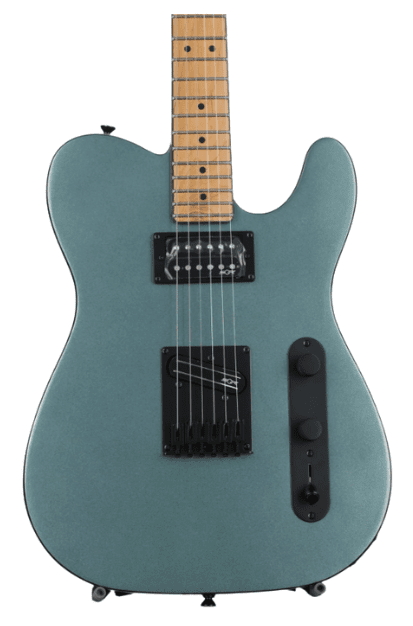
Squier Contemporary Telecaster
One of the coolest Telecasters to ever hit the market.
This Telecaster flips the script on everything you think you know about this classic design. It offers big humbucking tones from upgraded pickups that beg to be pushed hard, and it even features modern ergonomics for a fast, comfortable playing experience.
The Squier Contemporary Telecaster is one of the most unique and fun to play guitars that Fender has ever released under the Squier name. Not only does it offer unique tones, it offers unparalleled playability for a Tele in this price range, too.
As with almost all Squiers, it had a poplar body, but unlike typical Telecasters, it had a belly carve, which really assisted with comfort and ergonomics when playing seated. It was extremely light weight, too. The finish on our test model was “Gunmetal Metallic” which was really a great looking color that matched the black hardware perfectly.
The fretboard and neck were roasted maple, and again, they looked amazing. It felt great in the hand, and because it had a sculpted heel, we had unimpeded access to the upper frets, and this really let us explore the entire fretboard with ease. The neck had a nice mid thickness C profile, which felt quite similar to the modern C found on a lot of today’s Fender branded models.
We really liked the SQR pickups, which are Squier’s take on a hot pickup designed for heavier styles. It had 2 humbuckers, with a full size “Atomic” in the neck position, and a rail humbucker in the bridge. The rail helped to maintain the traditional Tele looks, while offering the edge needed to handle high gain in the bridge position, something not typically possible on a Telecaster. It didn’t deliver in the same way as a PAF humbucker, but it was
One of the most noticeable touches on the whole guitar is the collection of black hardware – the whole thing is blacked out from the saddles to the tuners, and it really nails the “metal” aesthetic. It came with Squier’s sealed gear tuning machines, and just like on the Affinity Strat, they performed really well for tuning stability, but made fine tuning a little difficult due to excess play.
Verdict: The Squier Contemporary Telecaster is one of our favorite models from Fender’s budget wing, and it’s one of the few genuine high quality options that players looking for a hard rock and metal focused guitar have in this price range.
- Great paint finishes
- Comfortable belly carve
- Sculpted heel
- Rail humbucker can sound thin
- Fine tuning was difficult
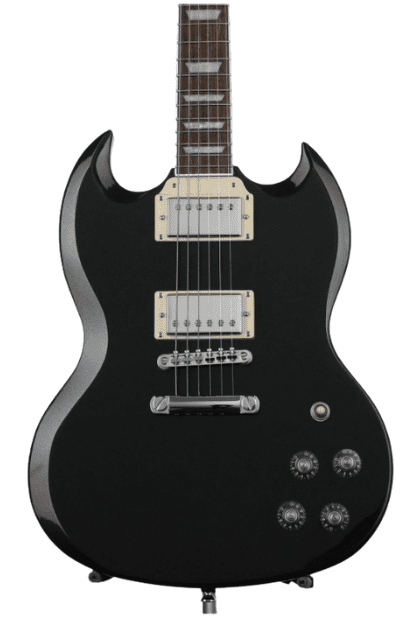
Epiphone SG Muse
A contemporary take on a classic model.
This SG is a classic reimagined. It delivers modern technology and playability, while retaining the beloved looks of a hard rock icon. It offers a fantastic opportunity to get your hands on one of the most beloved guitars of all time well within a $500 budget.
The Epiphone SG Muse is one of the newer models in the Epiphone SG family. It comes in a range of cool metallic colors and offers some features not found in the Standard or Custom models.
As is correct for the style, it had a full mahogany body, although unlike a Standard, it was weight relieved. It was finished in Jet Black Metallic, which differs from the regular Ebony finish in that it has a hint of a sparkle to it. It’s by far the most subtle of the available options. Because of the weight relief in the body, we did find that it suffered from the famous SG neck dive a little more noticeably than the SG custom we recently reviewed.
The set neck was also made from mahogany, but unlike the standard models it had a Custom C profile, which is significantly slimmer, and even more beginner friendly. Experienced players will also love this neck because of how fast it plays.
It had a laurel fretboard, which wasn’t bad at all in this case. It looked good, although a darker wood would have looked better against the Jet Black finish. Fret work as well executed, as we’ve found to be the case with pretty much every newer Epiphone.
We really liked the Alnico Classic Pro pickups with coil splitting (like the old G400 Pro). They were some of the hottest we heard in the whole roundup, and were perfect for overdriven rock and metal tones. Even though the SG Muse was best suited to high gain, it still responded well when played clean, with good articulation, and excellent note separation.
The hardware was all well selected, and installed with care and attention. It had a GraphTech nut, which is our favorite nut brand without a doubt. We liked the Epiphone Deluxe tuners, which performed well, although the 18:1 ratio did make fine tuning a little more difficult than we’d have liked.
Verdict: The Epiphone SG Muse was a ton of fun to play. We’re big fans of SGs at KGR, and we were really impressed by what Epiphone has managed to produce with the Muse while keeping the price under $500. It gave all the classic SG tones and more thanks to the coil splitting pickups, and the build quality was genuinely fantastic.
- GraphTech nut
- Versatile tones
- Comfortable neck
- 18:1 Tuner radio
- Neck dive

Gretsch G2210 Streamliner Junior Jet Club
Superb tones, incredible reliability and effortlessly cool styling.
This is a great choice for players looking for an easy playing single cut with fantastic retro styling and classic ‘50s humbucker tones. It’s comfortable and light weight, and offers fantastic playability for guitarists of all abilities to boot.
The Gretsch G2210 Junior Jet Club is right at the entry point to the Gretsch line up, but like the Les Paul Junior, it’s a great way to get the look and the tones while staying within budget.
The slab style body was made from nato, which is a commonly used mahogany substitute. It had a fantastic Gunmetal finish, but if that’s not your style, it’s also available in Gold Dust, Imperial Stain, and Vintage White, all of which look great.
It had a bolt on nato neck, which delivered snappy, responsive performance, and the thin U shaped profile was comfortable from top to bottom. Unfortunately playing speed was hampered a little by the glass neck finish, which felt a little sticky, but unless you’re trying to play lightning fast licks, this isn’t too big of a concern.
Surprisingly, we did like the laurel fretboard, and we especially liked the offset fret markers. They gave it a really unique look, and it really suited the overall aesthetic. The fretwork was good, with no sprout, and 22 well leveled medium jumbo wires providing a comfortable playing experience with no buzz and good intonation.
As for tones, we were expecting a ‘50s vibe (which we got in spades), but it gave us so much more on top of that. The growling rock tones were a particular highlight, but in addition we got some really nice warmth from the neck position, perfect for jazz and blues. The lead tones from the bridge were sharp and clear, and really responsive to changes in attack.
It had some nice Grover style tuners which contributed well to the excellent tuning stability. Unlike the full Jet Club models, this junior had a simple stop tail bridge with fixed compensated saddles. While out of the box intonation was good, these fixed saddles could make adjustments difficult if you were to make any major changes to the stock set up.
Verdict: The Gretsch G2210 Junior Jet Club offers unique looks and big vintage tones. The fit and finish were really fantastic considering the price, and the light weight contributed significantly to the comfortable playing experience.
- Retro vibe
- Great fit and finish
- Attractive price
- Fixed compensated saddle
- Sticky gloss finish on neck
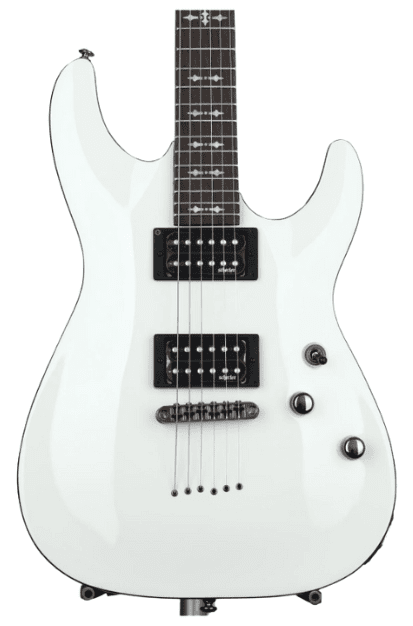
Schecter Omen 6
Possibly the fastest playing guitar in its price range.
This Schecter may have a more niche target audience, but if you’re looking for a lightning fast shredder with tons of character, fantastic styling, and great build quality under $500, then you really can’t go wrong with this guitar.
The Schecter Omen 6 has something of a cult following amongst those in the know, and for good reason. It’s a fast playing guitar with great all round playability, handsome looks, solid pickups, and massive metal tones.
The basswood body had a fantastic arch top. We found that this not only looked great, but provided improved ergonomics, giving us a more comfortable resting spot on the guitar for the strumming wrist, and this was particularly useful during repetitive downstroke playing. Our test model was finished in gloss white, and it really looked the part – the black binding and headstock really popped against the body.
We were big fans of the bolt on maple neck. It was a thin C profile, which felt reminiscent of famous Ibanez Wizard. Paired with the smooth, satin finish on the back, this translated to fast, effortless playability.
Around the front, the fretboard was made from rosewood, and was topped with pearloid “semi goth” fret markers. This was a really nice touch, and perfectly matched the aesthetic without being too “try hard”. We had no issues whatsoever with the fret work. The edges were adequately smooth, and everything was nicely leveled.
It featured a pair of Diamond Plus humbuckers which, as expected, performed brilliantly with high gain and distortion, retaining clarity while delivering punishing chug through our Mesa Rectifier profile on the Kemper. It did come apart a little when we tried to play clean, however. We found it to be a little muddy in both the neck and bridge positions, and while the majority of Schecter Omen 6 owners aren’t looking to play jazz or country, it does make it somewhat less versatile.
Clarity issues aside, we found that it had superb sustain, and this was likely down to the string through body. Being string through, this is a hardtail guitar, so if you’re looking for something with a vibrato system like a Floyd Rose, this might not be the best option for you.
Verdict: The Schecter Omen 6 is a lot of guitar for the money if you’re looking for something to exclusively play metal and heavier rock styles with. It’s an incredibly comfortable guitar, and serves up fast play, and it really looks quite special.
- Searing tones
- Extremely fast neck
- Excellent sustain
- No trem system
- Limited tonal range
How To Choose The Right Guitar For You
With a limited budget you really do need to be conscious of what it is you’re buying. Whether it’s something that’s a real all rounder, or a niche specific model you’re after, take a look at this buyer’s guide to get a better idea of what to look for.
Pickups
Most guitars will have one of these 3 types of pickup:
Single Coil
Single coil pickups are known for their bright, clear tones that pierce through mixes. They are fantastic when played clean and handle light overdrive very well, but will cause humming through our amp if exposed to any kind of electrical interference from even the most unassuming sources.
P90
P90 pickups are technically single coil, too, but they’re made with a wider bobbin that has a little more resistance to hum (although it doesn’t eliminate it). They have a signature snarl when pushed hard with overdriven or distorted amps, and it has made them extremely popular with rock players.
Humbucker
Humbuckers are a dual coil pickup engineered to cancel out the hum that single coils are susceptible to. The design works brilliantly, and has the added bonus of creating a thick, warm tone that handles high gain and distortion with greater ease than both P90 or single coil examples.
Alnico vs. Ceramic Pickups
Guitars under $500 will usually be fitted with either Alnico or ceramic pickups. Alnico magnets are softer than ceramic magnets, and this tends to result in a warmer, sweeter tone with excellent note separation, clarity, and articulation. The downside is, they are more expensive.
Ceramic magnets are known for their high output and hot tone. They deliver gritty, raspy tones, which in a good quality pickup can sound fantastic, but low cost examples can be harsh and thin. Ceramic magnet pickups tend to be noticeably cheaper than their alnico counterparts.
Bridge & Saddles
The bridge and saddles are an essential part of the guitar’s anatomy, and they play a big role in the intonation and tuning stability of a guitar. Particularly with relatively inexpensive models, such as those under the $500 threshold, this is something to look out for.
Cheaper guitars are more likely to need a setup than their pricier counterparts, and during a setup, adjustments might need to be made to the action or neck relief. When such modifications are made, intonation can easily be affected. If your guitar has individually adjustable saddles, this isn’t too much hassle, but in the event that it has a bridge with a fixed saddle, you may struggle to get it properly intonated again after a setup.
Final Thoughts
If you thought it was difficult to find anything decent under the $500 mark, we hope we’ve proven to you that there are some truly great options.
To recap, if you’re looking for a balance of price and performance, the Epiphone Les Paul Junior, our top pick, is the way to go. If you’re really looking to keep costs down and perhaps save some cash for an amp or accessories, take a look at our best value pick, the Squier Affinity Series Stratocaster HSS. Finally, if you’re looking for the very best guitar at $500 or less, our Editor’s Choice, the Yamaha Revstar Element RSE20 is the one to go for.

